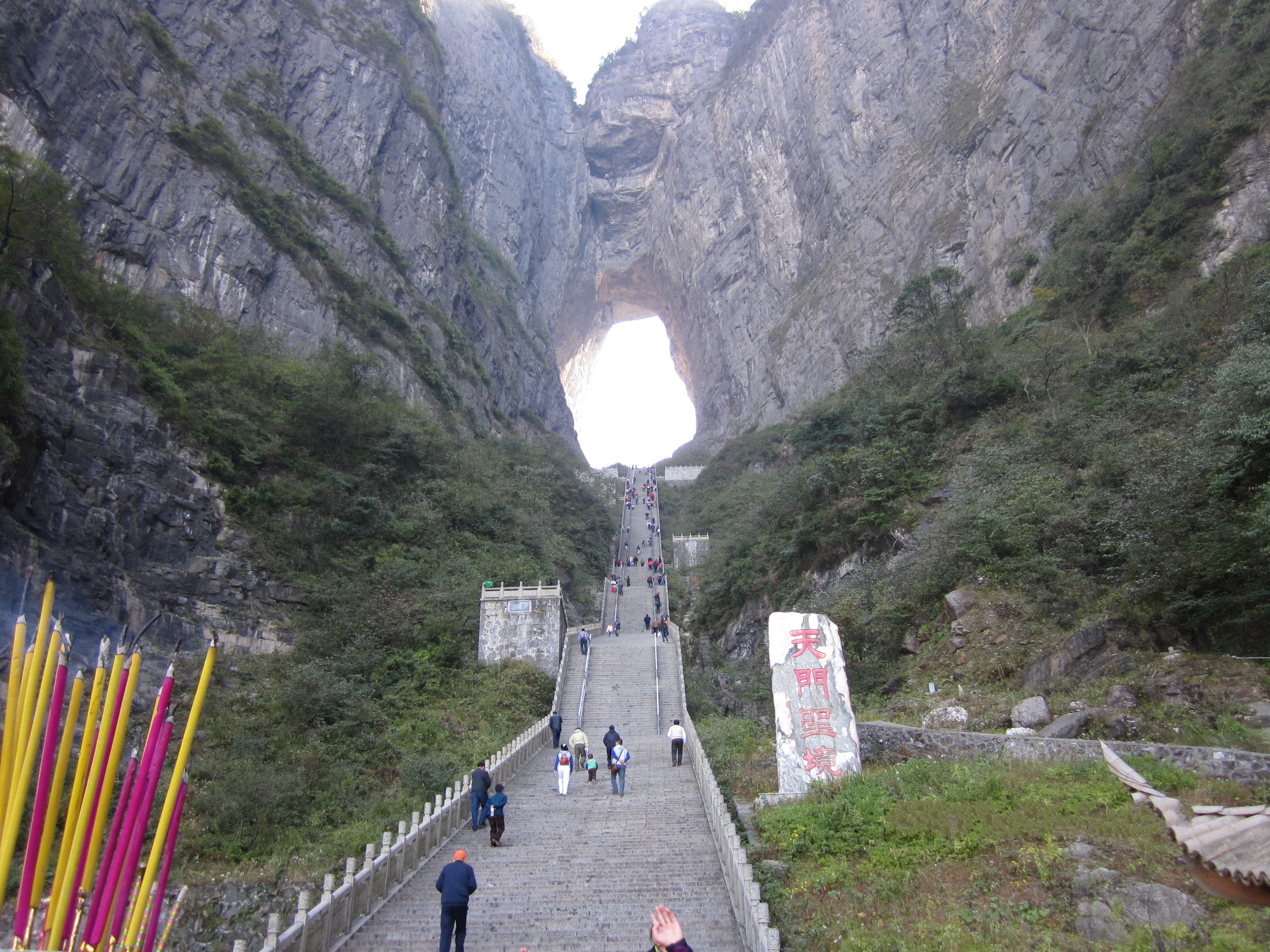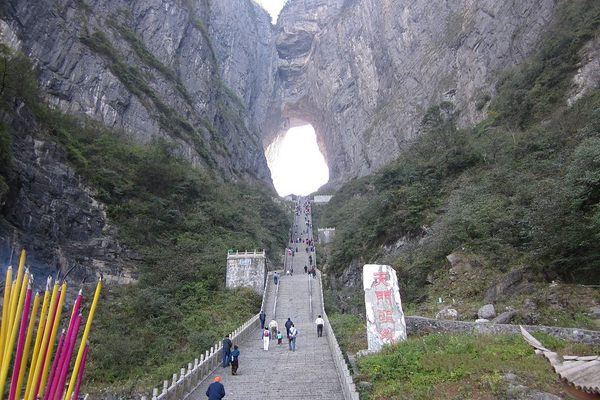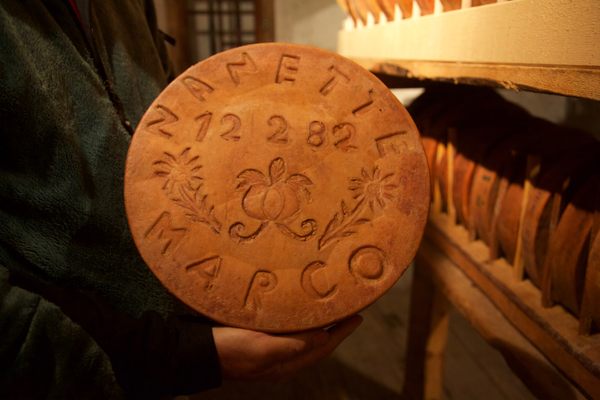Heaven is a Place: Six Gateways to the Great Beyond
Heaven, from Dante Alighieri’s “The Divine Comedy,” illustrated by Gustave Doré (via Wikimedia)
Atlas Obscura has explored many ways to enter the dark and dangerous underworld, but what about hell’s opposite?
Many cultures and religions’ concept of what happens to people after death includes the idea of a reward to the virtuous, whether it be joining the gods in their realm, or simply entering a peaceful land for the soul to dwell in. Sometimes, the spirit reaches this place of divine reward through a door on Earth.
In this Atlas Obscura guide, we’ve found the Earthly locations of many different passages into heavenly places. There are the homes of the gods themselves, there are also passageways to a magical world of eternal youth, and to a spirit world where one’s soul can join the ranks of honored ancestors, receiving godlike powers. In all of these heavens, those who are deserving receive a reward.
From the peaks of the Himalayas to the beaches of Maui, here is how you can get to the gates of Heaven.
Tianmen Shan
Zhangjiajii, China
 photograph by Huangdan2060/Wikimedia
photograph by Huangdan2060/Wikimedia
Tianmen Shan is a giant natural arch in a karst formation in the Hunan region of China. It is unique among natural arches in that its formation is part of recorded history — ancient Chinese documents report the entire opening formed when the back of a huge cave collapsed in 263 CE. After that cataclysmic event, the mountain’s name was changed to Tianmen Shan — “Heaven’s Gate Mountain.”
Local legends call this awe-inspiring geological phenomenon the connection between Earth and realm of the gods. Visitors climb 4,100 feet up 999 stone steps, often shrouded in ethereal fog, until reaching the peak of the mountain. Wooden huts along the path offer a place to rest and view the incredible scenery below and above.
If you don’t want to hike up to the entrance of heaven, travelers can take a 7.2 kilometer skytram suspended over rocky forest and mist-filled gorges. To really get the god’s eye view, the path up also includes a 200 foot long glass-bottomed pathway built into the side of the mountain — 4,000 feet up.
photograph by huangdan2060/Wikimedia
Mount Kailash
Kailas Range, The Himalayas, Tibet
photograph by Ondřej Žváček
The Himalayan mountain range is full of holy sites and ancient temples, but one mountain in particular stands out for its sacredness to not one, but four different religions.
To Tantric Buddhists, Mount Kailash is home to Buddha Demchong, representing supreme enlightenment. To Jains, it is the site where the first Jain attained nirvana. In Bon, an ancient Tibetan religion, the mountain and its entire surrounding region are the source of all mystical power. In Hindusim, it’s believed to be the residence of Lord Shiva and his consort Parvati, the land of eternal bliss. Within 30 kilometers of Mount Kailash are the sources of some of the longest rivers in Asia, including the Sutlej, the Indus, and the Ghaghara, a tributary of the Ganges.
Pilgrims make a four day offroad journey by jeep from Lhasa to the outpost of Darchen. Then they begin a 52 kilometer circumnavigation of the mountain, a holy ritual to bring good fortune, purity and enlightenment. The pilgrimage can take anywhere from a grueling 15 hours (for those seeking extra merit) to three weeks, making full body prostrations all along the way. Making 108 such journeys is said to bring assured enlightenment.
Despite Mount Kailash’s great spiritual significance, it is visited by only a few thousand pilgrims a year, mostly due to its extreme remoteness. No summits have been recorded. Climbing the mountain is in fact forbidden due to its holiness, and a permit given by the Chinese government to a Spanish climbing team in 2001 was angrily protested until it was rescinded.
Chortens & Mount Kailash (photograph by Yasunori Koide)
Mount Olympus
Greece
photograph by stefg74/Flickr user
Olympus was the ancient court of the Greek gods and goddesses, home to Zeus, Hera, Aphrodite, and other central deities. In Greek mythology, when mortal died, his soul typically went to Hades, but if a mortal proved exceptional, like Heracles or Pollux, then the gods would allow him join them on Mount Olympus.
In Homer’s Illiad, the home of the gods was described as glorious and full of trees. In the court itself, the gods were said to enjoy perfect weather and dine on nectar while planning their next entanglement on earth.
Olympus is the highest mountain in Greece, full of gorges, small caves, clear streams, and more than 1,700 kinds of plants. Its highest peak, Mytikas, is known as the “Pantheon” and was believed to be the gods’ meeting place, while the gods themselves settled in the mountain’s ravines. The mountain, as well as the surrounding national park, is full of popular hiking trails for any ability, and there are several lodges on where you can rent a bed for overnight hikes on your journey to heaven.
View to Mount Olympus from Thermaikos Bay (photograph by Marco Spaapen)
Passageways underneath the Pyramid of the Sun
Teotihuacan, Mexico
photograph by Antony Stanley
A sophisticated feat of engineering and architectural knowledge, the Pyramids of the Sun and Moon in Mexico’s ancient city of Teotihuacan have been intriguing visitors since their abandonment around 550 AD.
Construction of the city began around 100 BC, though the identities of the builders remain a mystery. The Toltecs were long accepted to be the architects, though recent research has also proposed the Maya, Mixtec, and Zapotec. What is known is the city was large, sophisticated, and at its zenith the largest in the pre-Colombian Americas. The temples and pyramids were used as a the sites for elaborate rituals, including human and animal sacrifice. Interestingly, the 30 square kilometers of the city does not include any military installments or fortifications.
Much about the meaning behind the city remains arcane, like the clover-shaped caves below the Pyramid of the Sun, excavated in 1971. The cave was apparently the setting for fire and water rituals, and may have been seen as a passageway from the spirit world to Earth. In the early Mesoamerican religious traditions, this spirit land was known as Tamoanchan. To the Aztecs, who later occupied Teotihuacan, Tamoanchan became a paradise full of precious birds, fountains, and flowers.
Archaeologists hypothesize the caves may have been the original places of worship, and then pyramids were built over them to commemorate the sacred spot. The caves are not currently open to the public, though the pyramids and the surrounding buildings along the Avenue of the Dead are an awe-inspiring exploration.
photograph by Cesar Bojorquez
Glastonbury Tor
Glastonbury, England
photograph by Jim Champion
The legendary entrance to Annwn, the paradise of Welsh mythology, is said to be on the summit of Glastonbury Tor, a hill outside the town of Glastonbury in Somerset, England.
Annwn is a world of eternal youth, with no disease and plentiful food and delights, ruled by the fairy king Arawn. Legend goes, it is accessible only through death or once a year through a secret door in Glastonbury Tor. Throughout the centuries the site has also become known as the location of Avalon, the land of the fairies where King Arthur rests until he is needed again.
The Tor is approximately 518 feet high, and capped with the ruined tower of St Michael’s Church, which was first constructed in the 12th century and collapsed and been rebuilt several times since then. Excavations show evidence of human visits since the Iron Age. The sides of the hill have seven deep terraces that might have been naturally formed or the result of Middle Age farmers sculpting the land for easier farming.
The wetlands surrounding the Tor sometimes create a Fata Morgana, where light bends through a mystical fog and creates the illusion of the Tor floating above the mist.
photograph by Edwin Graham
Pu’u Keka’a (Black Rock)
Maui, Hawaii
Black Rock Torch Lighting (photograph by Matt McGee)
Pu’u Keka’a (“Black Rock”) is a prominent lava-made landmark on Kaanapali Beach in Maui, surrounded by resorts and overlooking a gorgeous beach with renowned snorkeling spots. But there’s a deeper story behind the beautiful scenery. In the indigenous Hawaiian religion, Pu’u Keka’a was said to be a “ka-leine-a-ka-‘uhane,” or “leap of the soul” — a place where the souls of the dead jump from this world to the next. In several places throughout the Hawaiian islands, there are such leaping-off places — often high rocks facing the west.
Once a person died or came close to death, their spirit would be met by their departed friends and ancestors, often in the form of animals, who helped determine if the death was real. If they found you still had certain obligations or it wasn’t time for you to die, the spirits would help revive your body and return you to life. However, if the death was real, the spirits would help guide you to a leaping-off point, where your soul would jump to the next world. If you were honorable and law-abiding, your spirit lived with the chief god Kane, and you became a god.
The 18th-century King Kahekili was a great athlete, famous for his skill at lele kawa (cliff jumping). His favorite location for his spectacular cliff dives was Maui’s Black Rock, where his leaps had deep religious significance. Only someone with powerful mana, divine power, could jump unharmed after from the very place where the dead entered the next world. Kahekili’s impressive dives confirmed his sacred kingly status. Every evening at sunset, the nearby Sheraton Resort hosts a reenactment of the king’s impressive feat.
photograph by Matt McGee
Prefer paradise to get lost? Check out the Atlas Obscura guide to gates to hell >













Follow us on Twitter to get the latest on the world's hidden wonders.
Like us on Facebook to get the latest on the world's hidden wonders.
Follow us on Twitter Like us on Facebook